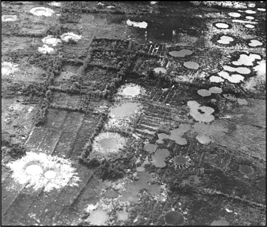
While President Nixon’s Vietnamization program had led to the evacuation of most American ground troops from South Vietnam, the U.S. government was still committed to the defense of its ally. It backed up that pledge of support with the use of air power in two campaigns known as Linebacker I and Linebacker II.

The aftermath of a B-52 air-strike mission on Vietnamese farmland leaves the countryside pockmarked with bomb craters, now filled with water.
Linebacker I was launched on May 10, 1972 in response to North Vietnam’s Easter Offensive in March. Using precision-guided munitions—the so-called “smart” bombs that contained small computerized aiming devices, unlike the previous bombs that had no “brain” and were simply dropped from planes—for the first time U.S. Air Force and Navy planes attacked highways, railroads, bridges, and warehouses as well as troop targets. When the operation ended, the bombings had severely disrupted the flow of supplies to the invading troops, causing the offensive to stall. Thanks to Linebacker I, the South Vietnamese Army was able to successfully counterattack and drive the invaders out.
Later that year, representatives from the United States, South Vietnam, North Vietnam, and the Viet Cong met in Paris, France, to discuss a peace treaty. The U.S. government became more and more frustrated because no progress was made in the meetings. The North Vietnamese representatives made unreasonable demands, including one that called for South Vietnam to disband its army while allowing North Vietnam to station its army in the south. And, after having made their demands, the North Vietnamese representatives would refuse to budge from their positions. Eventually, the talks broke off altogether. Finally, on December 13, 1972, President Nixon issued an ultimatum to the North Vietnamese government, demanding that it return to the negotiation table “or else.” When it refused, the president authorized the resumption of the air attack over North Vietnam. Linebacker II was launched on December 18, 1972. Called the “Christmas Bombings” by the United States press, B-52 bombers and other planes attacked strategic targets and antiaircraft defenses in Hanoi and in North Vietnam’s major port city, Haiphong, as well as other locations. On December 28, the North Vietnamese government agreed to reopen negotiations.